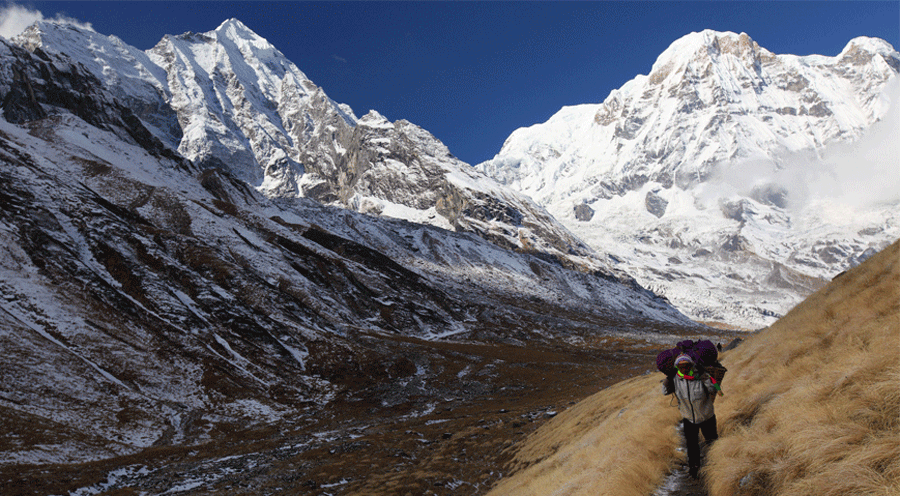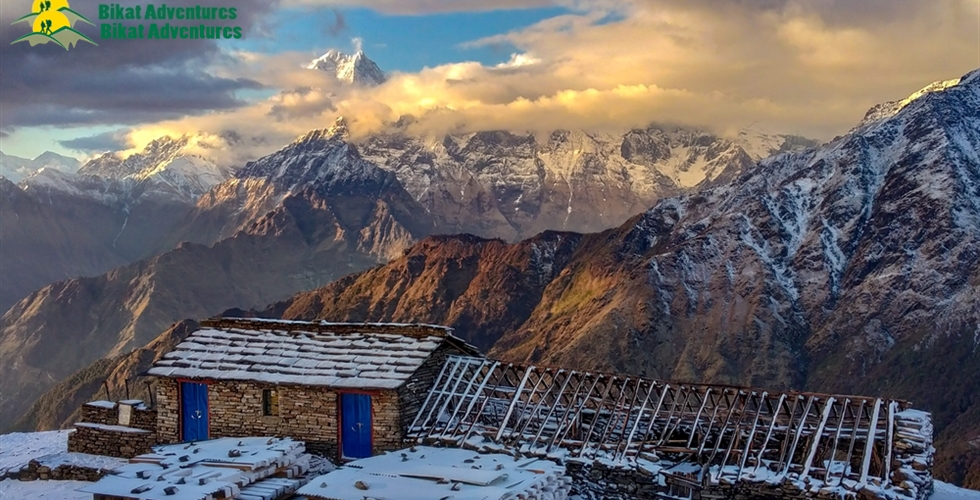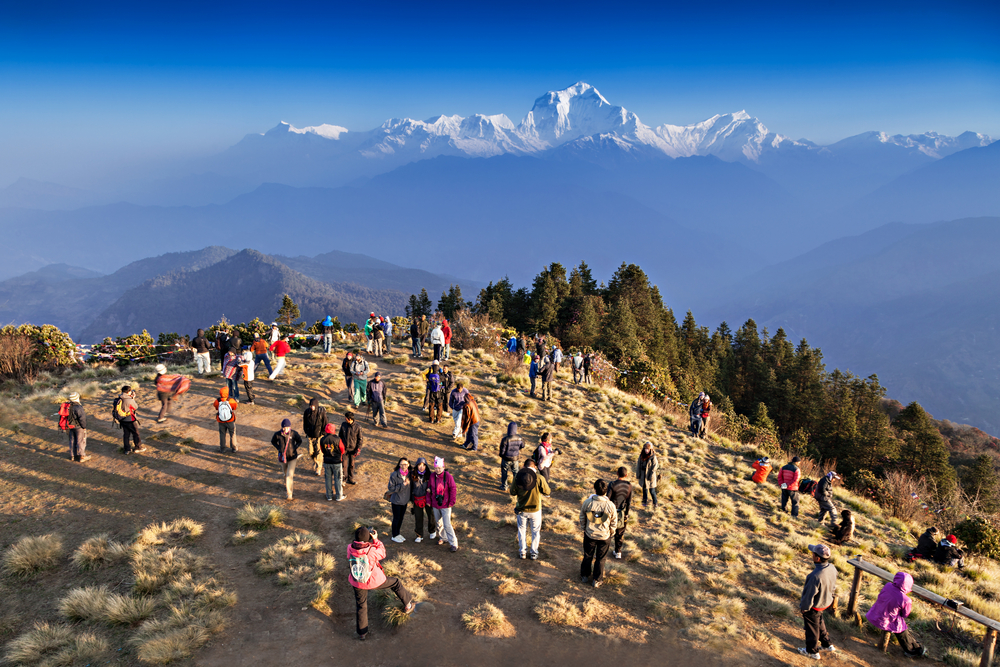The most popular trips in Nepal remain Everest Base Camp (very busy and not much of a sense of wilderness with lots of commercialization) and the Annapurna Circuit, an 18-day trek but now with a road built a long way into both ends. An alternative trail has been built to avoid the road (which generally follows the original trail), but it depends on the guide on how much road walking one does.
This trip was planned to walk across the entire south side of the Annapurnas to give views of the range in the best light and from a different perspective. The highlights from east to west are the foot-accessible town of Seclis and nearby Tara Hilltop, Annapurna Base Camp, and Khopra Ridge on the western edge of the range.
I joined the group in Kathmandu and we had a few days to explore the city and surrounding Unesco World Heritage Cultural Sites. With 13 porters (we are camping and cooking all our meals), Tom, Nima (our Nepalese guide who always works with Tom), Vishnu (our cook), the five of us and all our gear on the roof, we drove 206 km over 7 hours to Pokhara, in the middle of the country. It is the staging place for trips into the Annapurna Range.
Day 1. With 4 more porters from Pokhara, we took a second bus the next day to Begnas Tal Bazaar, a small town on the shores of the second largest lake in Nepal, Begnas Tal. We had a short hike high above the lake to camp on a small peninsula jutting into the lake.
Day 2. Almost every day begins with crystal clear skies and outstanding views of the Annapurnas to the north. Machhapuchhre or Fish Tail Peak (6997m), the main mountain in view for the next 19 days, poked up above the foothills. A sacred peak, it has never been climbed and is the only mountain in Nepal off-limits.
We climbed above the high ridge to the west of the lake, passed the town of Twaudanda, and descended one of the magnificent rough stone stairways to reach the Madi Nadi River at Bhagawatitar (1035m). The shrill whine of cicadas accompanied us everywhere. We walked through rice paddies to SW of the bridge to camp on an old rice terrace. All the local kids were shy, spoke little English and were content to sit and watch us for hours.
Day 3 We crossed the superb suspension bridge with its wide metal decking and walked through small farms with chickens, cows and water buffalo and along the cliffs above the river. The Madi Nadi was crossed where it makes a big bend to the north. We climbed up to a road with a bus loaded with 10 locals riding on the roof. The kids asked for money. After this brief contact with the outside world, it was a walk back down to the river and the boundary of the Annapurna Conservation Area Project (ACAP). We had to show our ACAP and Nepali Trekking permits – available in Kathmandu and Pokhara (need 2 passport photos). Signs state that this is an ‘open defecation-free zone’ which I guess means you shouldn’t.
Day 4 We walked along the river on the gravel bar strewn with boulders, over headlands and passed through two lovely villages composed entirely of stone – walls, walkways, houses and terraces. Our lunch spot was shared with chickens, goats and dogs. It was then a huge climb through chest-high rice with stone-walled terraces to the small town of Parche, our camp spot for 2 nights to explore the Seclis area about a 30-minute walk to the north. We all had leeches – they looked like earthworms with suckers on each end, flip-flopping around like slinkies.
Day 5 Camped high above town next to the soccer field, we woke to panoramic views of the entire eastern Annapurnas. We contoured above Seclis through herds of water buffalo, cattle and goats to Rishing Danda, a viewpoint high above Seclis, to see Lumjung and Annapurna IV and II disappear in the clouds.
We then walked down through the town of 2400 cascading down the hillside. 85% are Gurung (a big ethnic group that was the main people for the entire trek – everybody’s last name is Gurung). All houses were long, one-story stone buildings with metal roofs and large courtyards in front for the drying of rice and millet and small silos for storing corn. Water taps bringing fresh mountain water were all over town. It is still vehicleless as the rough road was washed out in three places within a kilometre of town.
Back at camp, the soccer field was full of kids, craftspeople were selling their stuff, and they had an amitole (a cultural event with singing and dancing) to raise money.
Day 6 We wake up to a hot cup of milk tea and a wash basin of hot water delivered to our tent at 6 every morning. Breakfast is served on a tarpaulin at 6:45 usually in bright sunshine with the sun hitting the high peaks. By 7:30, we are walking – today to leave the Seclis area to head west. Traversing above Parche with huge views down to the jeep road and Madi Nadi far below, we passed lovely waterfalls and creeks.
After the usual leisurely 1 1/2 hour lunch, we climbed to a high ridge called Tara Hilltop at 2800m. The walk was through a magnificent mature rhododendron forest with some trees 6′ across the base. Moss, ferns, vines and bromeliads covered the trees. Tara Hilltop is a camping-only place. We were joined by two other trekking groups for our first encounter with foreigners.

Day 7. We woke up at 6 for panoramic views of the entire Annapurnas from west to east: Annapurna South and I, Machhapuchhre, Gangapurna, Annapurna II and IV and Lamjung hit by the rising sun. It was several degrees below zero. After walking along the long ridge. we descended a steep rock stairway 1300m to Ghalekharka where the rice harvest was beginning. It was down a rough 4WD road to Khardarjung, a large town with many stairs, across the Seti Nadi River and uphill to Ghachok where we camped in a schoolyard.
Our 4 young porters from Pokhara left us here. This was a 2-week school holiday during Dasain, the main festival of the year. Everyone had elaborate tikas. Swings made from 4 huge pieces of bamboo and wood Ferris wheels are set up. The 4 seats filled with laughing kids are moved by hand.
Day 8 We stayed high contouring close to the mountainside through many rice paddies often walking on the narrow stone terrace walls. Still, in Gurung territory, the stone houses had adjoining sheds filled with cows and goats. After lunch in a stone courtyard of a house, we crossed the Mardi Khola River and climbed up a gorgeous stone stairway past isolated houses, rice paddies and stone platforms to Lwang where we camped in another schoolyard. A teacher came to open the school for our cooks as a kitchen and Penny gave the teacher pencils, notebooks and assorted school supplies.
Day 9. After my first shave, we had a big climb on stairs and then contoured on an overgrown trail that was virtually clear when walked by Tom and Nima last April. I had 9 leeches on my abdomen, back and legs, all leaving large patches of clotted blood. We eventually reached the main trekking trail to Annapurna Base Camp (ABC) at Pitam Deurali (Deurali = pass) at 2100m.
With views up the trail towards ABC, we now encountered lodges and hoards of other trekkers on their way to ABC, the main destination in south Annapurna. There were big groups, maybe 10% camping but most staying in lodges, and many independent small groups often with a guide and or porter. Most guides were of little value as there was only one way to go. We descended to Tolka to camp.
Day 10 After a long descent past Landruk to the Madi Knola River (which comes down from ABC) and nice waterfalls, we crossed the river at New Bridge and started the long climb up to Jhinhu. The popular hot springs here are a long climb down and were not worthwhile. We continued the climb to Chhomrong where we would return in 5 days. At the top are lodges with internet and German Bakeries with excellent apple crumble. We descended to a guesthouse where we stayed on the lawn, our most common camping spot for the rest of the trip. We pay to camp and often get to use their nice dining facilities in the cold. Most days have had highs in the high 20s with cool nights. That will change as we begin the big climb up to ABC.
Day 11 There was a long descent down to a side river and then a longer climb up to Sinuwa, many ups and downs above the river through Kuldigar and Bamboo to Dovan. Signs announced to not bring chicken, pork or buffalo up to the sanctuary or we would meet personal calamity.
Day 12 Tom was taking it easy on us and we had 2 short walking days. The first was to Deurali where we camped on a goat pasture beside a lodge. We were now in a much steeper walled valley and Machhapuchhre just peeked above the rim. Waterfalls tumbled off the cliffs.
Day 13 was a 2-hour, 500m climb to Machhapuchhre Base Camp at 3700m. We walked well above the river on a rough trail with no stairs or stone walkways. I dealt with well below freezing temperatures in my +4 degree bag by sleeping in two tops, merino long johns, socks and a fleece liner lent by one of the couples. Annapurna South filled the valley west toward ABC for a great sunrise light show.

This was an amazing adventure. With good company, excellent care by the porters, cook, guide and Tom, and some of the best trekking in Nepal, we all felt satisfied. The views of the Annapurnas from the south were outstanding and the 28 days flew by. My only regret was not losing more weight.





